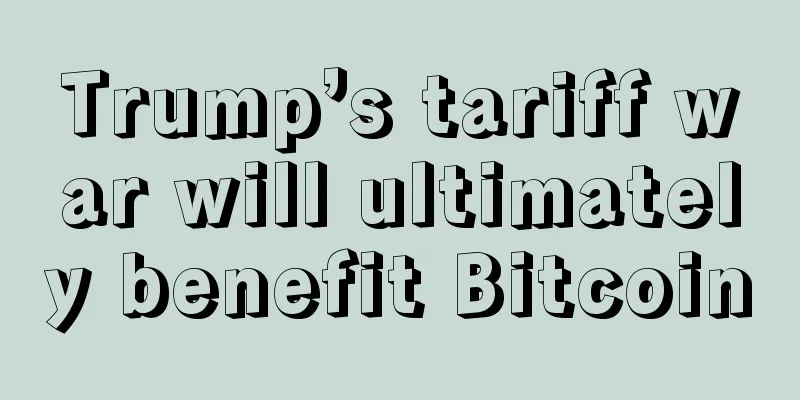Trump’s tariff war will ultimately benefit Bitcoin

|
Crypto markets have retreated sharply in the past few days, with Bitcoin down about 5% and many other assets down much more. As I write this Monday morning in London (where I’m attending a conference), Ethereum is down 17%, Solana is down 8%, and XRP is down 18%. The immediate cause of the pullback was concerns about a global trade war. Over the weekend, President Trump imposed 25% tariffs on most imports from Canada and Mexico and 10% tariffs on China, and the three countries announced their response plans. The move caused the dollar to rise more than 1% against other major currencies and led to sharp declines in stock futures and cryptocurrency prices. Of course, since this is encryption, the trouble doesn't end there. In the cryptocurrency space, due to the widespread use of leverage, sharp market movements (especially on weekends when liquidity is low) tend to be self-exacerbated. Negative news events cause prices to fall, which causes leveraged traders to close their positions by selling, which causes prices to fall, forcing more people to close their positions. This process continues until the leverage is exhausted. Sure enough, the largest liquidation event in cryptocurrency history occurred in the 24 hours from Sunday night to Monday morning, with potentially up to $10 billion in leveraged positions being liquidated. Bitwise investors tend to be long-term investors, so these short-term, leverage-driven pullbacks are viewed by most as opportunities rather than threats — as long as the news event is truly short-term. So, is it really so? That’s the trillion dollar question. My colleague Jeff Park, who leads Bitwise’s Alpha team and is one of the sharpest minds at the intersection of macro and crypto, argues that Trump’s economic game plan, including the implementation of tariffs, is actually a long-term positive catalyst for Bitcoin. Now I asked Jeff to share his views: The outcome is: Bitcoin wins, fiat loses. In either case, Bitcoin will go higher. To understand the long-term impact of tariffs on Bitcoin, there are two things to keep in mind: 1) the curse of the “Triffin Dilemma,” and 2) President Trump’s long-term goals. First is the Triffin dilemma, named after the Belgian-American economist who coined the term in the 1960s, which refers to the fact that being the world's reserve currency has both advantages and disadvantages. On the negative side, the dollar is structurally overvalued because other countries need it as a reserve currency (regardless of its price) and the US must run a persistent trade deficit to supply dollars to the world. On the positive side, the US government can continually borrow cheaper than it “should” because there are persistent buyers for its debt. Trump wants to eliminate the negatives and keep the positives. How does Trump plan to achieve this? Tariffs. Tariffs are usually temporary negotiating tools to achieve a goal - which seems to be the case this time. We believe the ultimate goal is to reach a multilateral agreement to weaken the dollar without raising long-term interest rates. One possible way to do this is to force countries to reduce their dollar reserves while extending the maturity of Treasury bonds. This would suppress long-term interest rates while supporting the US manufacturing base. But how do you get countries to agree to this? You have to force them to the negotiating table. The United States has done this before. In 1985, West Germany, France, the United Kingdom, and Japan signed the famous Plaza Accord, which called for an orderly devaluation of the dollar against other currencies. The agreement gave a huge boost to American manufacturers, which had previously struggled to compete on the global stage due to the strong dollar. (Why did these countries sign the agreement? One reason was—you guessed it—the fear of tariffs.) If Trump can bully his way to this outcome, there is no asset more favorable than Bitcoin. Lower interest rates will stimulate risk appetite among U.S. investors, pushing up Bitcoin prices. Abroad, countries will face economic weakness and will resort to traditional economic stimulus measures to compensate, again pushing up Bitcoin prices. What if he fails? What if we get a prolonged tariff war? We firmly believe that the resulting economic weakness will lead to more money printing than ever before. Historically, such stimulus has been very bullish for Bitcoin. |
<<: What kind of Bitcoin strategic reserve should the United States implement?
>>: What hit the crypto market hard during the Spring Festival holiday?
Recommend
How to tell the situation of parents, brothers and children from their faces
1. See your parents 1. Look at the corners of the...
Ethereum merger is imminent. Let's talk about PoW and PoS from the perspective of community thinking
As Vitalik said, the Ethereum merge is expected t...
Behind the gold-farming craze among blockchain game guilds: the transformation from mostly miners poses multiple risks
In August this year, when Yield Guild Games follo...
Learn face reading quickly into a song
Learn face reading quickly into a song 1. Head: 1...
What is the fate of people with low nose bridge?
If the nose bridge is well-shaped, then the facia...
Bitcoin's market value has surpassed the Korean won's total market value and is about to surpass Google's parent company
On March 12, according to foreign media reports, ...
Are people with red palms healthier?
A healthy person's palms should be pink; very...
Fortune telling by bone weighing: what will happen on May 3rd, Gengyin year at Chou hour?
Although many people think that fortune-telling b...
What is the fate of people with broken palms in their past and present lives?
In Taoism, there is the concept of the six realms ...
What does Ju Men Ming Palace represent?
The star Ju Men has the characteristics of being ...
Is it good for a woman to have moles under her eyes? Is it good for a woman to have thin lips?
Moles on the face will inevitably affect the appea...
Can the base of your fingers predict your fate?
The base of the fingers refers to the place where...
A "digital currency" scam was discovered in Suqian, Jiangsu, with the amount involved reaching 2.2 million
The recent central bank digital currency has beco...
What does a mole next to the mouth mean for men and women?
The mouth is the most important part of a person....
What does the mole on the hand mean?
As one of the traditional physiognomy techniques, ...









